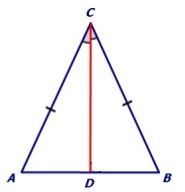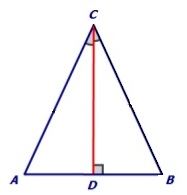Isosceles Triangle Theorems
You may have already learnt about the properties and types of triangles. One of the special types of a triangle is the isosceles triangle. An isosceles triangle is a triangle which has two equal sides, no matter in what direction the apex (or peak) of the triangle points. Some pointers about isosceles triangles are:
- It has two equal sides.
- It has two equal angles, that is, the base angles.
- When the third angle is 90 degree, it is called a right isosceles triangle.
In this article, we have given two theorems regarding the properties of isosceles triangles along with their proofs.
Isosceles Triangle Theorems and Proofs
Theorem 1: Angles opposite to the equal sides of an isosceles triangle are also equal.
Proof: Consider an isosceles triangle ABC where AC = BC.
We need to prove that the angles opposite to the sides AC and BC are equal, that is, ∠CAB = ∠CBA.

We first draw a bisector of ∠ACB and name it as CD.
Now in ∆ACD and ∆BCD we have,
AC = BC (Given)
∠ACD = ∠BCD (By construction)
CD = CD (Common to both)
Thus, ∆ACD ≅∆BCD (By SAS congruence criterion)
So, ∠CAB = ∠CBA (By CPCT)
Hence proved.
Theorem 2: Sides opposite to the equal angles of a triangle are equal.
Proof: In a triangle ABC, base angles are equal and we need to prove that AC = BC or ∆ABC is an isosceles triangle.

Construct a bisector CD which meets the side AB at right angles.
Now in ∆ACD and ∆BCD we have,
∠ACD = ∠BCD (By construction)
CD = CD (Common side)
∠ADC = ∠BDC = 90° (By construction)
Thus, ∆ACD ≅ ∆BCD (By ASA congruence criterion)
So, AC = BC (By CPCT)
Or ∆ABC is isosceles.
To learn more about isosceles triangles, their properties and examples based on the theorems discussed above, download BYJU’S – The Learning App.